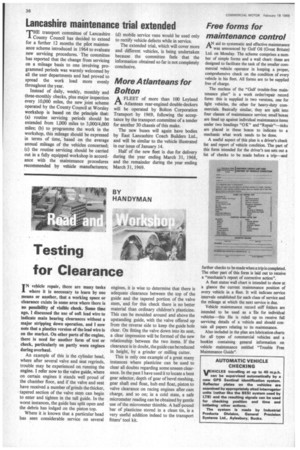Testing for Clearance
Page 38

If you've noticed an error in this article please click here to report it so we can fix it.
TN vehicle repair, there are many tasks where it is necessary to learn by one means or another, that a working space or clearance exists in some area where there is no possibility of visible check. Some time ago, I discussed the use of soft lead wire to indicate main bearing clearances without a major stripping down operation, and I now note that a plastics version of the lead wire is on the market. On other parts of the engine, there is need for another form of test or check, particularly on partly worn engines during overhaul.
An example of this is the cylinder head, where after several valve and seat regrinds, trouble may be experienced on running the engine. I refer now to the valve guide, where on certain engines it stands well proud of the chamber floor, and if the valve and seat have received a number of grinds the thicker, tapered section of the valve stem can begin to enter and tighten in the tall guide. In the worst instances, the guide has split open and the debris has lodged on the piston top.
Where it is known that a particular head has seen considerable service on several engines, it is wise to determine that there is adequate clearance between the top of the guide and the tapered portion of the valve stem, and for this check there is no better material than ordinary children's plasticine. This can be moulded around and above the upstanding guide, with the valve offered up from the reverse side to keep the guide hole clear. On fitting the valve down into its seat, a clear impression will be formed of the new relationship between the two items. If the clearance is in doubt, the guide can be reduced in height, by a grinder or milling cutter.
This is only one example of a great many instances where plasticine can be used to clear all doubts regarding some unseen clearance. In the past I have used it to locate a bent gear selector, depth of gear of bevel meshing, gear shaft end float, hub end float, piston to valve clearance on racing engines after cam charge, and so on; in a cold state, a safe micrometer reading can be obtained by gentle use of the micrometer thimble. A half-pound bar of plasticine stored in a clean tin, is a very useful addition indeed to the transport fitters' tool kit.




















































































































